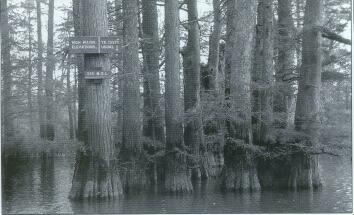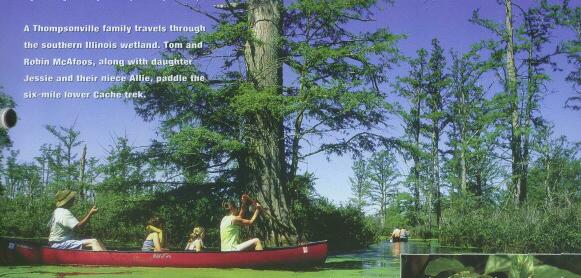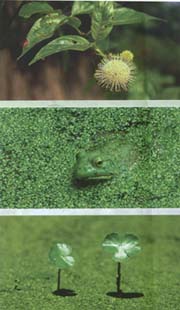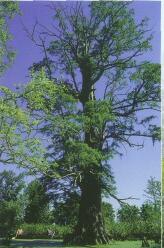|
Cache Incentives
BY BURKE SPEAKER
PHOTOS BY ADELE HODDE
AND CHAS. J. DEES
First-time
swamp paddler
stung by ignorance,
not mosquitos,
in an eye-opening
trek down the
Cache River.
The canoe glides through neon-green duckweed on the Cache
River, past cypress trees that are
more than 500 years old.
By the time our canoes edged away from the swampy Cache
River shoreline, skimming through soupy layers of neon green
duckweed, the sun's upward trek had nearly peaked, and I warily began
preparing for an onslaught of plasmathirsty mosquitos. My already sunscorched skin tingled at the thought
of those diminutive parasites plunging microscopic needles into my
arms, legs, neck or any other uncovered extremity. Primed to see a true
swamp in Illinois, an unquestionable befuddlement for those who've traveled the state, I anticipated a day
defending my O-positive supply against those rancorous thistle bugs.
There is little doubt I was naive,
alright, ignorant concerning what
swamps are like. I had bought into
the Hollywood version of dirty
waters, rabid snakes and mosquitos
like watermelons. Still, I was willing
to accept a future ointment bath (also
I had snagged a friend's can of insect
repellent) to paddle a part of Illinois
few realize exists. Living my entire
life in this state, I had not heard of
the Cache until a year ago. Gullibility
had assured me the Prairie State
couldn't possibly house bald cypress,
tupelo gum and an assortment of
swamp critters. This is why, had
there been mosquitos, I probably
would have swallowed most of them
when my jaw fell agape at my first
sighting of Illinois' very own, and
very unHollywood, swampland.
All around me were bald cypress
trees, their trunks dark with moisture
as they leech into the water, sucking
up nourishment that causes such
immense height and grandeur. Their
leaf-adorned branches soaked in the
sunlight and doubled as hostesses for
a slew of chorusing birds that watched
us pass. At the trees' base, the puzzling knee features awkwardly protrude from the water. Dozens of these
dull, wooden daggers surround each
tree's base. It is said they provide stability for the ancient historians, though
to me they appeared as stoic gnomes
huddled together in hushed secrecy,
cloaked in robes of moss.
Being summer, the air stayed
heavy and warm, though a light
wind blew in periodically to cool us
down. After we paddled for awhile,
the bird songs quieted, and the only
sound heard was the inevitable
plunking our duckweed-coated paddles made dipping into the water.
Then, in the distance, a low-pitched
screech echoed across the water, and
a great blue heron swooped silently
behind a transparent cypress curtain.
I stopped paddling to watch, knowing that if any creature demands
respect in this murky land, it is the
great blue. There is something
ancient and elusive in its flight.
Darting above us, chimney swifts
circled the sky, leaving their protected
nests in some hollow cypress to search
out insects. An assortment of waterfowl, including hooded mergansers
and wood ducks, plus warblers, egrets
and turkey vultures, call the Cache
River home. I noticed other strange
birds, and I silently cursed myself for
being so ignorant when it comes to
memorizing different bird species.
|
September 2000 7

Signs mark the water level
from previous years' floods,
which raised the river high above
its normal range.
|
On top of the multitude of birds,
animal life is equally impressive.
Otters and bobcats are sighted periodically along the Cache, though
they usually remain elusive. Their
home bears a fitting name, for in
French, Cache translates to 'hidden.'
The bow of the metallic canoe
bobbed forward, and our paddles commenced stirring the duckweed stew as
we drifted by post-flowering button
bushes. Paddling was becoming more
arduous as the thick duckweed, layered with 10 different species types,
forced us to slow down and absorb the
scenery. It wasn't too difficult to succumb to this particular demand. The
trek was a path into a fairy tale, another realm I foolishly deemed impossible
to encounter in the corn-besieged flat-lands of Illinois. What made it all the
more magical was the knowledge that
this was an area first destroyed, then
revived, by man.
It is paradoxical to imagine the
mentality of early European settlers
who came upon this wetland more
than 200 years ago. At the time, settlers viewed swamps as filthy places
of disease, and crossing the swamp
meant possible sickness or death.
Cache River Natural Area site superintendent Jim Waycuilis calls the
area the 'Graveyard of the Midwest,'
because of the hundreds of settlers
who died here of malaria. Fearing
that mysterious 'swamp gas' was
causing the disease, and believing
swamps only hampered human
endeavors, the decided-upon
chemotherapy was to exterminate the
swamps. Lumber needs reinforced
the land-clearing desire and beginning in the 20th century the swamps
were drained, and the alien landscape
nearly became another Illinois pasture. The water wouldn't come back
for good until 1982, when two conservancy groups won a court battle to
return the water to the Cache.
Oddly enough, it was later
learned the swamp gas theory was a
fallacy, and science revealed that
mosquitos were to blame for spreading the disease.
I suddenly remembered that I
hadn't been skeeter-attacked once,
nor even seen a semblance of those
little kamikazes. A teal dragonfly
buzzed past the canoe as if on cue;
the secret revealed. With the amount
of dragonflies, frogs and toads in the
swampy Cache River, Waycuilis said,
mosquitos are seldom bothersome to
the paddler. The bugs are terrible
around the marshy inland, but gliding
across the water , not a mosquito soul
could be found.
Not that I would have cared. The
canoeing was
becoming even
more enjoyable,
the soothing river
silence interrupted
|
Cache
River
|

|
only by the call of a great blue heron
or fish splashing in front of the bow.
There were no loud mechanical noises, large crowds or traffic here. It was
noon and the only rush was the wind
occasionally urging us forward. We
rounded a brushy bend, past more
cypress and approached the state
champion bald cypress, a 73-foot tall
giant more than 1,000 years of age.
The timekeeper was struck by lightning many times, and its top had long
since blown off. Still, it stood mighty
and proud, much to the disdain of the
lightning, I suppose.
Gazing up at the giant provokes
thoughts of what mysteries this old
tree has seen, and what history
occurred under its branches, or
above, for that matter. Most of the
cypress are from 500 to 1,000 years
of age. To put it in perspective, when
Columbus arrived at what he would
call the Americas, many of these
trees were already 500 years old. I
expect the early, indigenous people
canoed this same water, maybe even
stopping for rest beneath what is now
the state champ. After a moment, we
slowly left the regal leader, and its
branches swayed a farewell, always
watching and surveying its domain.
We followed the international
canoe trail markers as the river oozed
along. The Cache, which begins near
Cobden in Union county, was actually
carved out by the Ohio River prior to
it changing course. The 110-mile river
is divided into two unique sections;
the upper and lower Cache. The only
part of the river that can be canoed is
the lower Cache. Canoeing the upper
Cache is out of the question, as severe
bank erosion has left felled trees
impossible to maneuver around.
Looking skyward, I noticed the
sun was dipping lower. We had
canoed three miles into the swamps
Burke Speaker is an intern
serving as a staff writer for
OutdoorIllinois. Originally from
Galena, Burke attends Southern Illinois University, where
he is majoring in journalism.
8 OutdoorIllinois

 of the Cache River, and now we
reluctantly paddled back to shore,
worming our way along backwaters
to the main river channel, and finally,
to the dock. Vacating the canoe, I
stretched, tired and sore, but exhilarated. The canoe trip lasted mere
hours, but in that time I had meandered through a landscape that
wasn't supposed to exist in Illinois.
of the Cache River, and now we
reluctantly paddled back to shore,
worming our way along backwaters
to the main river channel, and finally,
to the dock. Vacating the canoe, I
stretched, tired and sore, but exhilarated. The canoe trip lasted mere
hours, but in that time I had meandered through a landscape that
wasn't supposed to exist in Illinois.
 Walking back to the vehicle, the
wind ceased, and I could smell the
swampy, damp air. I figured that, as
with many other national and state
natural treasures, man's relationship
with the Cache is one of ignorance,
realization and then, preservation. I
paused at the car door for another look
at the river, and turned to leave, mentally pledging a return visit-minus the
unused can of bug spray, of course.
Walking back to the vehicle, the
wind ceased, and I could smell the
swampy, damp air. I figured that, as
with many other national and state
natural treasures, man's relationship
with the Cache is one of ignorance,
realization and then, preservation. I
paused at the car door for another look
at the river, and turned to leave, mentally pledging a return visit-minus the
unused can of bug spray, of course.
For canoeing or other information
about the Cache River contact the
Cache River Natural Area at (618)
634-9678. The river can be accessed at
the Lower Cache River Access or for
$1 by private boat launch. Canoes can
be rented for $25 by calling Cache
Core Canoes at (6l8) ,845-3817.

September 2000 9
|

